Dynamic Behavior and Permanent Indentation in S2-Glass Woven Fabric Reinforced Polymer Composites under Impact: Experimentation and High-Fidelity Modeling
Abstract
:1. Introduction
2. Materials and Methods
2.1. Experimental Activities
2.2. Numerical Model
2.2.1. Interlaminar and Intralaminar Damage Models
2.2.2. Nonlinear Material Constitutive Behaviour
2.2.3. Definition of the Model
| Lamina Properties | Symbol [unit] | Value |
|---|---|---|
| Density | ρ [kg/m3] | 1740 **** |
| Initial modulus | E0 [GPa] | 36.5 * |
| Asymptotic stress level | [MPa] | 900 * |
| Shape parameter | m | 1.24 * |
| Elastic modulus | E3 [GPa] | 11.8 ** [65] |
| Shear modulus | [GPa] | 1.81 * |
| Shear modulus | , [GPa] | 2.14 ** [65] |
| Poisson’s ratio | 0.12 ** [65] | |
| Poisson’s ratio | , | 0.18 ** [65] |
| Tensile strength 1 | [MPa] | 482.8 * |
| Compressive strength 1 | [MPa] | 333.2 ** [65] |
| Tensile strength 2 | [MPa] | 482.8 * |
| Compressive strength 2 | [MPa] | 337.3 ** [65] |
| Shear strength 12 | [MPa] | 82 * |
| Shear strength 13 | [MPa] | 58 *** [90] |
| Intralaminar fracture toughness | , [N/mm] | 30 *** [95] |
| Interface properties | ||
| Contact stiffness | [GPa] | 12.1 *** [96] |
| [GPa] | 3.4 *** [96] | |
| Strength | [MPa] | 45.9 *** [96] |
| [MPa] | 49.5 *** [96] | |
| Interlaminar fracture toughness | [N/mm] | 0.98 *** [96] |
| [N/mm] | 3.71 *** [96] | |
| Mode interaction | 1.4 *** [96] |
3. Results
3.1. Experimental Observations
3.1.1. Impact Force, Displacement and Absorbed Energy
3.1.2. Damaged Area
3.2. Numerical Results
4. Discussion
5. Conclusions
Author Contributions
Funding
Data Availability Statement
Conflicts of Interest
References
- Sun, X.C.; Hallett, S.R. Barely Visible Impact Damage in Scaled Composite Laminates: Experiments and Numerical Simulations. Int. J. Impact Eng. 2017, 109, 178–195. [Google Scholar] [CrossRef]
- Polimeno, U.; Meo, M. Detecting Barely Visible Impact Damage Detection on Aircraft Composites Structures. Compos. Struct. 2009, 91, 398–402. [Google Scholar] [CrossRef]
- Wu, Z.; Zhang, L.; Ying, Z.; Ke, J.; Hu, X. Low-Velocity Impact Performance of Hybrid 3D Carbon/Glass Woven Orthogonal Composite: Experiment and Simulation. Compos. B Eng. 2020, 196, 108098. [Google Scholar] [CrossRef]
- Shah, S.Z.H.; Karuppanan, S.; Megat-Yusoff, P.S.M.; Sajid, Z. Impact Resistance and Damage Tolerance of Fiber Reinforced Composites: A Review. Compos. Struct. 2019, 217, 100–121. [Google Scholar] [CrossRef]
- de Moura, M.F.S.F.; Marques, A.T. Prediction of low velocity impact damage in carbon–epoxy laminates. Compos. Part A: Appl. Sci. Manuf. 2002, 33, 361–368. [Google Scholar] [CrossRef]
- Rezasefat, M.; Ma, D.; da Silva, A.A.X.; Colombo, C.; Amico, S.C.; Giglio, M.; Manes, A. Multi-Criteria Decision-Making Analysis and Numerical Simulation of the Low-Velocity Impact Response of Inter-Ply S2-Glass/Aramid Woven Fabric Hybrid Laminates. Compos. Struct. 2023, 312, 116867. [Google Scholar] [CrossRef]
- Cao, W.; Zhang, J.; Sun, B.; Gu, B. X-ray Tomography and Numerical Study on Low-Velocity Impact Damages of Three-Dimensional Angle-Interlock Woven Composites. Compos. Struct. 2019, 230, 111525. [Google Scholar] [CrossRef]
- Boukar, A.; Corn, S.; Slangen, P.R.L.; Ienny, P. Finite Element Modelling of Low Velocity Impact Test Applied to Biaxial Glass Fiber Reinforced Laminate Composites. Int. J. Impact Eng. 2022, 165, 104218. [Google Scholar] [CrossRef]
- Hinton, M.J.; Kaddour, A.S.; Soden, P.D. Failure Criteria in Fibre Reinforced Polymer Composites: The World-Wide Failure Exercise; Elsevier: Amsterdam, The Netherlands, 2004; ISBN 0080426999. [Google Scholar]
- Sjoblom, P.O.; Hartness, J.T.; Cordell, T.M. On Low-Velocity Impact Testing of Composite Materials. J. Compos. Mater. 1988, 22, 30–52. [Google Scholar] [CrossRef]
- Naik, N.K.; Chandra Sekher, Y.; Meduri, S. Damage in Woven-Fabric Composites Subjected to Low-Velocity Impact. Compos. Sci. Technol. 2000, 60, 731–744. [Google Scholar] [CrossRef]
- Tita, V.; de Carvalho, J.; Vandepitte, D. Failure Analysis of Low Velocity Impact on Thin Composite Laminates: Experimental and Numerical Approaches. Compos. Struct. 2008, 83, 413–428. [Google Scholar] [CrossRef]
- Schoeppner, G.A.; Abrate, S. Delamination Threshold Loads for Low Velocity Impact on Composite Laminates. Compos. Part A Appl. Sci. Manuf. 2000, 31, 903–915. [Google Scholar] [CrossRef]
- Baucom, J.N.; Zikry, M.A. Low-Velocity Impact Damage Progression in Woven E-Glass Composite Systems. Compos. Part A Appl. Sci. Manuf. 2005, 36, 658–664. [Google Scholar] [CrossRef]
- Aslan, Z.; Karakuzu, R.; Okutan, B. The Response of Laminated Composite Plates under Low-Velocity Impact Loading. Compos. Struct. 2003, 59, 119–127. [Google Scholar] [CrossRef]
- Richardson, M.O.W.; Wisheart, M.J. Review of Low-Velocity Impact Properties of Composite Materials. Compos. Part A Appl. Sci. Manuf. 1996, 27, 1123–1131. [Google Scholar] [CrossRef]
- De Moura, M.F.S.F.; Gonçalves, J.P.M. Modelling the Interaction between Matrix Cracking and Delamination in Carbon–Epoxy Laminates under Low Velocity Impact. Compos. Sci. Technol. 2004, 64, 1021–1027. [Google Scholar] [CrossRef]
- Hou, J.P.; Petrinic, N.; Ruiz, C. A Delamination Criterion for Laminated Composites under Low-Velocity Impact. Compos. Sci. Technol. 2001, 61, 2069–2074. [Google Scholar] [CrossRef]
- Hinton, M.J.; Kaddour, A.S.; Soden, P.D. Failure Criteria in Fibre-Reinforced-Polymer Composites; Elsevier: Amsterdam, The Netherlands, 2004; pp. 1–1255. [Google Scholar] [CrossRef]
- Chen, P.; Shen, Z.; Xiong, J.; Yang, S.; Fu, S.; Ye, L. Failure Mechanisms of Laminated Composites Subjected to Static Indentation. Compos. Struct. 2006, 75, 489–495. [Google Scholar] [CrossRef]
- Zhou, J.; Wen, P.; Wang, S. Finite element analysis of a modified progressive damage model for composite laminates under low-velocity impact. Compos. Struct. 2019, 225, 111113. [Google Scholar] [CrossRef]
- Militello, C.; Epasto, G.; Bongiorno, F.; Zuccarello, B. First Lamina Hybridization of High Performance CFRP with Kevlar Fibers: Effect on Impact Behavior and Nondestructive Evaluation. Mech. Adv. Mater. Struct. 2022, 30, 1207–1222. [Google Scholar] [CrossRef]
- Teng, X.; Xu, Y.; Hui, X.; Zhang, W.; Dai, H.; Liu, W.; Ma, C.; Li, Y. Experimental Study on the Low-Velocity Impact and Post-Impact Flexural Properties of Curved CFRP Laminates Reinforced by Pre-Hole Z-Pinning (PHZ) Technique. Mech. Adv. Mater. Struct. 2022, 30, 3479–3490. [Google Scholar] [CrossRef]
- Kannivel, S.; Subramanian, H.; Arumugam, V.; Dhakal, H.N. Low-Velocity Impact Induced Damage Evaluation and Its Influence on the Residual Flexural Behavior of Glass/Epoxy Laminates Hybridized with Glass Fillers. J. Compos. Sci. 2020, 4, 99. [Google Scholar] [CrossRef]
- Grasso, M.; Xu, Y. Threshold Identification and Damage Characterization of Woven GF/CF Composites under Low-Velocity Impact. J. Compos. Sci. 2022, 6, 305. [Google Scholar] [CrossRef]
- Maier, R.; Mandoc, A.C. Investigation on Layer Hybridization of Glass/Carbon Fibre Woven Reinforced Composites Subjected to Low-Speed Impact. J. Compos. Sci. 2023, 7, 83. [Google Scholar] [CrossRef]
- Rezasefat, M.; da Silva, A.A.X.; Amico, S.C.; Giglio, M.; Manes, A. Repeated Impact Behaviour of Inter-Ply Hybrid Aramid/S2-Glass Epoxy Laminates. Thin-Walled Struct. 2023, 186, 110680. [Google Scholar] [CrossRef]
- Minak, G.; Ghelli, D. Influence of Diameter and Boundary Conditions on Low Velocity Impact Response of CFRP Circular Laminated Plates. Compos. B Eng. 2008, 39, 962–972. [Google Scholar] [CrossRef]
- Sadighi, M.; Alderliesten, R. Impact Fatigue, Multiple and Repeated Low-Velocity Impacts on FRP Composites: A Review. Compos. Struct. 2022, 297, 115962. [Google Scholar] [CrossRef]
- Li, Z.; Ameri, A.A.H.; Hazell, P.J.; Khennane, A.; Escobedo-Diaz, J.P.; Aryal, B.; Wang, H. Effects of Impactor Mass on the Low-Velocity Impact Behaviour of Thick GFRP Pultruded Laminates. Constr. Build. Mater. 2021, 279, 122491. [Google Scholar] [CrossRef]
- Cao, H.; Ma, M.; Jiang, M.; Sun, L.; Zhang, L.; Jia, L.; Tian, A.; Liang, J. Experimental Investigation of Impactor Diameter Effect on Low-Velocity Impact Response of CFRP Laminates in a Drop-Weight Impact Event. Materials 2020, 13, 4131. [Google Scholar] [CrossRef] [PubMed]
- Dogan, A. Single and Repeated Low-Velocity Impact Response of E-Glass Fiber-Reinforced Epoxy and Polypropylene Composites for Different Impactor Shapes. J. Thermoplast. Compos. Mater. 2022, 35, 320–336. [Google Scholar] [CrossRef]
- Kazemianfar, B.; Esmaeeli, M.; Nami, M.R. Response of 3D Woven Composites under Low Velocity Impact with Different Impactor Geometries. Aerosp. Sci. Technol. 2020, 102, 105849. [Google Scholar] [CrossRef]
- Rezasefat, M.; da Silva, A.A.X.; Amico, S.C.; Giglio, M.; Manes, A. Strain-Rate Dependent FDEM Simulation of the Perforation Behaviour of Woven Composites Subjected to Low-Velocity Impact. In International Symposium on Dynamic Response and Failure of Composite Materials; Springer International Publishing: Cham, Switzerland, 2023; pp. 307–315. [Google Scholar] [CrossRef]
- Lopes, C.S.; Sádaba, S.; González, C.; Llorca, J.; Camanho, P.P. Physically-Sound Simulation of Low-Velocity Impact on Fiber Reinforced Laminates. Proc. Int. J. Impact Eng. 2016, 92, 3–17. [Google Scholar] [CrossRef]
- Kinvi-Dossou, G.; Bonfoh, N.; Matadi Boumbimba, R.; Koutsawa, Y.; Lachaud, F.; Nyoungue, A.; Gerard, P. A Mesoscale Modelling Approach of Glass Fibre/Elium Acrylic Woven Laminates for Low Velocity Impact Simulation. Compos. Struct. 2020, 252, 112671. [Google Scholar] [CrossRef]
- Bogenfeld, R.; Kreikemeier, J.; Wille, T. Review and Benchmark Study on the Analysis of Low-Velocity Impact on Composite Laminates. Eng. Fail. Anal. 2018, 86, 72–99. [Google Scholar] [CrossRef]
- Mao, C.; Zhang, C. Numerical Analysis of Influence Factors on Low-Velocity Impact Damage of Stitched Composite Laminates. Mech. Adv. Mater. Struct. 2018, 27, 1019–1028. [Google Scholar] [CrossRef]
- Hoseinlaghab, S.; Farahani, M.; Safarabadi, M.; Jalali, S.S. Comparison and Identification of Efficient Nanoparticles to Improve the Impact Resistance of Glass/Epoxy Laminates: Experimental and Numerical Approaches. Mech. Adv. Mater. Struct. 2022, 20, 694–709. [Google Scholar] [CrossRef]
- Rezasefat, M.; Giglio, M.; Manes, A. Numerical Investigation of the Effect of Open Holes on the Impact Response of CFRP Laminates. Appl. Compos. Mater. 2022, 29, 1555–1578. [Google Scholar] [CrossRef]
- Rezasefat, M.; Amico, S.C.; Giglio, M.; Manes, A. A Numerical Study on the Influence of Strain Rate in Finite-Discrete Element Simulation of the Perforation Behaviour of Woven Composites. Polymers 2022, 14, 4279. [Google Scholar] [CrossRef]
- Rezasefat, M.; Gonzalez-Jimenez, A.; Giglio, M.; Manes, A. Numerical Study on the Dynamic Progressive Failure Due to Low-Velocity Repeated Impacts in Thin CFRP Laminated Composite Plates. Thin-Walled Struct. 2021, 167, 108220. [Google Scholar] [CrossRef]
- Rezasefat, M.; Torres, D.B.; Gonzalez-Jimenez, A.; Giglio, M.; Manes, A. A Fast Fracture Plane Orientation Search Algorithm for Puck’s 3D IFF Criterion for UD Composites. Mater. Today Commun. 2021, 28, 102700. [Google Scholar] [CrossRef]
- Rezasefat, M.; Beligni, A.; Sbarufatti, C.; Amico, S.C.; Manes, A. Experimental and Numerical Study of the Influence of Pre-Existing Impact Damage on the Low-Velocity Impact Response of CFRP Panels. Materials 2023, 16, 914. [Google Scholar] [CrossRef] [PubMed]
- Tan, W.; Falzon, B.G.; Chiu, L.N.S.; Price, M. Predicting Low Velocity Impact Damage and Compression-After-Impact (CAI) Behaviour of Composite Laminates. Compos. Part A Appl. Sci. Manuf. 2015, 71, 212–226. [Google Scholar] [CrossRef]
- Shi, Y.; Swait, T.; Soutis, C. Modelling Damage Evolution in Composite Laminates Subjected to Low Velocity Impact. Compos. Struct. 2012, 94, 2902–2913. [Google Scholar] [CrossRef]
- Singh, H.; Mahajan, P. Modeling Damage Induced Plasticity for Low Velocity Impact Simulation of Three Dimensional Fiber Reinforced Composite. Compos. Struct. 2015, 131, 290–303. [Google Scholar] [CrossRef]
- Bouvet, C.; Rivallant, S.; Barrau, J.J. Low Velocity Impact Modeling in Composite Laminates Capturing Permanent Indentation. Compos. Sci. Technol. 2012, 72, 1977–1988. [Google Scholar] [CrossRef]
- Fanteria, D.; Longo, G.; Panettieri, E. A Non-Linear Shear Damage Model to Reproduce Permanent Indentation Caused by Impacts in Composite Laminates. Compos. Struct. 2014, 111, 111–121. [Google Scholar] [CrossRef]
- Bouvet, C.; Rivallant, S. Damage Tolerance of Composite Structures under Low-Velocity Impact. In Dynamic Deformation, Damage and Fracture in Composite Materials and Structures, 2nd ed.; Woodhead Publishing: Cambridge, UK, 2023; pp. 3–28. [Google Scholar] [CrossRef]
- Jiang, H.; Liu, X.; Jiang, S.; Ren, Y. Hybrid Effects and Interactive Failure Mechanisms of Hybrid Fiber Composites under Flexural Loading: Carbon/Kevlar, Carbon/Glass, Carbon/Glass/Kevlar. Aerosp. Sci. Technol. 2023, 133, 108105. [Google Scholar] [CrossRef]
- Hongkarnjanakul, N.; Rivallant, S.; Bouvet, C.; Miranda, A. Permanent Indentation Characterization for Low-Velocity Impact Modelling Using Three-Point Bending Test. J. Compos. Mater. 2013, 48, 2441–2454. [Google Scholar] [CrossRef]
- Ivañez, I.; Garcia-Castillo, S.K.; Sanchez-Saez, S.; Barbero, E. Experimental Study of the Impact Behavior of Repaired Thin Laminates with Double Composite Patch. Mech. Adv. Mater. Struct. 2018, 27, 1701–1708. [Google Scholar] [CrossRef]
- He, W.; Guan, Z.; Li, X.; Liu, D. Prediction of Permanent Indentation Due to Impact on Laminated Composites Based on an Elasto-Plastic Model Incorporating Fiber Failure. Compos. Struct. 2013, 96, 232–242. [Google Scholar] [CrossRef]
- Wang, Y.; Zhang, J.; Fang, G.; Zhang, J.; Zhou, Z.; Wang, S. Influence of Temperature on the Impact Behavior of Woven-Ply Carbon Fiber Reinforced Thermoplastic Composites. Compos. Struct. 2018, 185, 435–445. [Google Scholar] [CrossRef]
- Ge, X.; Zhang, P.; Zhao, F.; Liu, M.; Liu, J.; Cheng, Y. Experimental and Numerical Investigations on the Dynamic Response of Woven Carbon Fiber Reinforced Thick Composite Laminates under Low-Velocity Impact. Compos. Struct. 2022, 279, 114792. [Google Scholar] [CrossRef]
- Tuo, H.; Lu, Z.; Ma, X.; Xing, J.; Zhang, C. Damage and Failure Mechanism of Thin Composite Laminates under Low-Velocity Impact and Compression-after-Impact Loading Conditions. Compos. B Eng. 2019, 163, 642–654. [Google Scholar] [CrossRef]
- Tuo, H.; Lu, Z.; Ma, X.; Zhang, C.; Chen, S. An Experimental and Numerical Investigation on Low-Velocity Impact Damage and Compression-after-Impact Behavior of Composite Laminates. Compos. B Eng. 2019, 167, 329–341. [Google Scholar] [CrossRef]
- Erdogan, G.; Bilisik, K. Compression after Low-Velocity Impact (CAI) Properties of Multistitched Composites. Mech. Adv. Mater. Struct. 2017, 25, 623–636. [Google Scholar] [CrossRef]
- Li, Z.; Khennane, A.; Hazell, P.J.; Brown, A.D. Impact Behaviour of Pultruded GFRP Composites under Low-Velocity Impact Loading. Compos. Struct. 2017, 168, 360–371. [Google Scholar] [CrossRef]
- Abdallah, E.A.; Bouvet, C.; Rivallant, S.; Broll, B.; Barrau, J.J. Experimental Analysis of Damage Creation and Permanent Indentation on Highly Oriented Plates. Compos. Sci. Technol. 2009, 69, 1238–1245. [Google Scholar] [CrossRef]
- Bouvet, C.; Castanié, B.; Bizeul, M.; Barrau, J.J. Low Velocity Impact Modelling in Laminate Composite Panels with Discrete Interface Elements. Int. J. Solids Struct. 2009, 46, 2809–2821. [Google Scholar] [CrossRef]
- Vieille, B.; Casado, V.M.; Bouvet, C. About the Impact Behavior of Woven-Ply Carbon Fiber-Reinforced Thermoplastic- and Thermosetting-Composites: A Comparative Study. Compos. Struct. 2013, 101, 9–21. [Google Scholar] [CrossRef]
- Elias, A.; Laurin, F.; Kaminski, M.; Gornet, L. Experimental and Numerical Investigations of Low Energy/Velocity Impact Damage Generated in 3D Woven Composite with Polymer Matrix. Compos. Struct. 2017, 159, 228–239. [Google Scholar] [CrossRef]
- Da Silva, A.A.X.; Scazzosi, R.; Manes, A.; Amico, S.C. High-Velocity Impact Behavior of Aramid/S2-Glass Interply Hybrid Laminates. Appl. Compos. Mater. 2021, 28, 1899–1917. [Google Scholar] [CrossRef]
- Kumar, Y.; Rezasefat, M.; Amico, S.C.; Manes, A.; Dolez, P.I.; Hogan, J.D. Comparison of Two Progressive Damage Models for Predicting Low-Velocity Impact Behavior of Woven Composites. Thin-Walled Struct. 2024, 197, 111611. [Google Scholar] [CrossRef]
- ASTM D7136/D7136M-15; Standard Test Method for Measuring the Damage Resistance of a Fiber-Reinforced Polymer Matrix Composite to a Drop-Weight Impact Event. ASTM International: West Conshohocken, PA, USA, 2015.
- Liu, H.; Falzon, B.G.; Tan, W. Experimental and Numerical Studies on the Impact Response of Damage-Tolerant Hybrid Unidirectional/Woven Carbon-Fibre Reinforced Composite Laminates. Compos. B Eng. 2018, 136, 101–118. [Google Scholar] [CrossRef]
- Raghavan, P.; Ghosh, S. A Continuum Damage Mechanics Model for Unidirectional Composites Undergoing Interfacial Debonding. Mech. Mater. 2005, 37, 955–979. [Google Scholar] [CrossRef]
- Kim, E.H.; Rim, M.S.; Lee, I.; Hwang, T.K. Composite Damage Model Based on Continuum Damage Mechanics and Low Velocity Impact Analysis of Composite Plates. Compos. Struct. 2013, 95, 123–134. [Google Scholar] [CrossRef]
- Rezasefat, M.; Mostafavi, Y.; Ma, D.; Manes, A. A Hybrid Micro-Macro Mechanical Damage Model to Consider the Influence of Resin-Rich Zones on the Transverse Tensile Behaviour of Unidirectional Composites. Compos. Struct. 2023, 308, 116714. [Google Scholar] [CrossRef]
- Alonso, L.; Martínez-Hergueta, F.; Garcia-Gonzalez, D.; Navarro, C.; García-Castillo, S.K.; Teixeira-Dias, F. A Finite Element Approach to Model High-Velocity Impact on Thin Woven GFRP Plates. Int. J. Impact Eng. 2020, 142, 103593. [Google Scholar] [CrossRef]
- López-Puente, J.; Zaera, R.; Navarro, C. Experimental and Numerical Analysis of Normal and Oblique Ballistic Impacts on Thin Carbon/Epoxy Woven Laminates. Compos. Part A Appl. Sci. Manuf. 2008, 39, 374–387. [Google Scholar] [CrossRef]
- Shi, Y.; Pinna, C.; Soutis, C. Modelling Impact Damage in Composite Laminates: A Simulation of Intra- and Inter-Laminar Cracking. Compos. Struct. 2014, 114, 10–19. [Google Scholar] [CrossRef]
- Bažant, Z.P.; Oh, B.H. Crack Band Theory for Fracture of Concrete. Matériaux Constr. 1983, 16, 155–177. [Google Scholar] [CrossRef]
- Chen, W.F.; Bazant, Z.P.; Planas, J.; Kim, S.-E.; Lui, E.M.; Mossallam, K.H.; Toma, S.; Toma, S.; Cheung, Y.K.; Tham, L.G.; et al. Fracture and Size Effect in Concrete and Other Quasibrittle Materials; Routledge: New York, NY, USA, 2019. [Google Scholar] [CrossRef]
- Rezasefat, M.; Mostafavi, Y.; Hogan, J.D.; Giglio, A.M. Simple Projection Method: A Novel Algorithm for Estimation of Characteristic Element Length in Finite Element Simulations of Composites. Int. J. Fract. 2024. [Google Scholar]
- ABAQUS, version 6.16; Analysis User’s Manual; Dassault Systemes Simulia, Inc.: Johnston, RI, USA, 2016.
- Liu, P.F.; Liao, B.B.; Jia, L.Y.; Peng, X.Q. Finite Element Analysis of Dynamic Progressive Failure of Carbon Fiber Composite Laminates under Low Velocity Impact. Compos. Struct. 2016, 149, 408–422. [Google Scholar] [CrossRef]
- Lee, C.S.; Kim, J.H.; Kim, S.K.; Ryu, D.M.; Lee, J.M. Initial and Progressive Failure Analyses for Composite Laminates Using Puck Failure Criterion and Damage-Coupled Finite Element Method. Compos. Struct. 2015, 121, 406–419. [Google Scholar] [CrossRef]
- Benzeggagh, M.L.; Kenane, M. Measurement of Mixed-Mode Delamination Fracture Toughness of Unidirectional Glass/Epoxy Composites with Mixed-Mode Bending Apparatus. Compos. Sci. Technol. 1996, 56, 439–449. [Google Scholar] [CrossRef]
- Zhou, J.; Wen, P.; Wang, S. Numerical Investigation on the Repeated Low-Velocity Impact Behavior of Composite Laminates. Compos. B Eng. 2020, 185, 107771. [Google Scholar] [CrossRef]
- Rezasefat, M.; Gonzalez-Jimenez, A.; Giglio, M.; Manes, A. An Evaluation of Cuntze and Puck Inter Fibre Failure Criteria in Simulation of Thin CFRP Plates Subjected to Low Velocity Impact. Compos. Struct. 2021, 278, 114654. [Google Scholar] [CrossRef]
- Vogler, M.; Rolfes, R.; Camanho, P.P. Modeling the Inelastic Deformation and Fracture of Polymer Composites—Part I: Plasticity Model. Mech. Mater. 2013, 59, 50–64. [Google Scholar] [CrossRef]
- Cousigné, O.; Moncayo, D.; Coutellier, D.; Camanho, P.; Naceur, H.; Hampel, S. Development of a New Nonlinear Numerical Material Model for Woven Composite Materials Accounting for Permanent Deformation and Damage. Compos. Struct. 2013, 106, 601–614. [Google Scholar] [CrossRef]
- Bogetti, T.A.; Hoppel, C.P.R.; Harik, V.M.; Newill, J.F.; Burns, B.P. Predicting the Nonlinear Response and Progressive Failure of Composite Laminates. Compos. Sci. Technol. 2004, 64, 329–342. [Google Scholar] [CrossRef]
- Bogetti, T.A.; Hoppel, C.P.R.; Harik, V.M.; Newill, J.F.; Burns, B.P. Predicting the Nonlinear Response and Failure of Composite Laminates: Correlation with Experimental Results. Compos. Sci. Technol. 2004, 64, 477–485. [Google Scholar] [CrossRef]
- Zhong, S.; Guo, L.; Lu, H.; Zeng, T. A continuum damage model for three-dimensional woven composites and finite element implementation. Compos. Struct. 2015, 128, 1–9. [Google Scholar] [CrossRef]
- Xiao, J.R.; Gama, B.A.; Gillespie, J.W. Progressive Damage and Delamination in Plain Weave S-2 Glass/SC-15 Composites under Quasi-Static Punch-Shear Loading. Compos. Struct. 2007, 78, 182–196. [Google Scholar] [CrossRef]
- Gama, B.A.; Gillespie, J.W. Finite Element Modeling of Impact, Damage Evolution and Penetration of Thick-Section Composites. Int. J. Impact Eng. 2011, 38, 181–197. [Google Scholar] [CrossRef]
- Zhang, J.; Zhang, X. Simulating Low-Velocity Impact Induced Delamination in Composites by a Quasi-Static Load Model with Surface-Based Cohesive Contact. Compos. Struct. 2015, 125, 51–57. [Google Scholar] [CrossRef]
- ASTM D3039; Standard Test Methods for Tensile Properties of Polymer Matrix Composite Materials. Annual Book of ASTM Standards. ASTM International: West Conshohocken, PA, USA, 2014.
- Schön, J. Coefficient of Friction of Composite Delamination Surfaces. Wear 2000, 237, 77–89. [Google Scholar] [CrossRef]
- Faggiani, A.; Falzon, B.G. Predicting Low-Velocity Impact Damage on a Stiffened Composite Panel. Compos. Part A Appl. Sci. Manuf. 2010, 41, 737–749. [Google Scholar] [CrossRef]
- Martínez-Hergueta, F.; Ares, D.; Ridruejo, A.; Wiegand, J.; Petrinic, N. Modelling the In-Plane Strain Rate Dependent Behaviour of Woven Composites with Special Emphasis on the Non-Linear Shear Response. Compos. Struct. 2019, 210, 840–857. [Google Scholar] [CrossRef]
- Perillo, G.; Jørgensen, J.K. Numerical/Experimental Study of the Impact and Compression after Impact on GFRP Composite for Wind/Marine Applications. Procedia Eng. 2016, 167, 129–137. [Google Scholar] [CrossRef]
- Shah, S.Z.H.; Megat-Yusoff, P.S.M.; Karuppanan, S.; Choudhry, R.S.; Ahmad, F.; Sajid, Z.; Gerard, P.; Sharp, K. Performance Comparison of Resin-Infused Thermoplastic and Thermoset 3D Fabric Composites under Impact Loading. Int. J. Mech. Sci. 2021, 189, 105984. [Google Scholar] [CrossRef]
- Liu, D.; Raju, B.B.; Dang, X. Impact Perforation Resistance of Laminated and Assembled Composite Plates. Int. J. Impact Eng. 2000, 24, 733–746. [Google Scholar] [CrossRef]
- Hufenbach, W.; Gude, M.; Ebert, C.; Zscheyge, M.; Hornig, A. Strain Rate Dependent Low Velocity Impact Response of Layerwise 3D-Reinforced Composite Structures. Int. J. Impact Eng. 2011, 38, 358–368. [Google Scholar] [CrossRef]
- Choudhry, R.S.; Hassan, S.F.; Li, S.; Day, R. Damage in Single Lap Joints of Woven Fabric Reinforced Polymeric Composites Subjected to Transverse Impact Loading. Int. J. Impact Eng. 2015, 80, 76–93. [Google Scholar] [CrossRef]
- Baucom, J.N.; Zikry, M.A.; Rajendran, A.M. Low-Velocity Impact Damage Accumulation in Woven S2-Glass Composite Systems. Compos. Sci. Technol. 2006, 66, 1229–1238. [Google Scholar] [CrossRef]
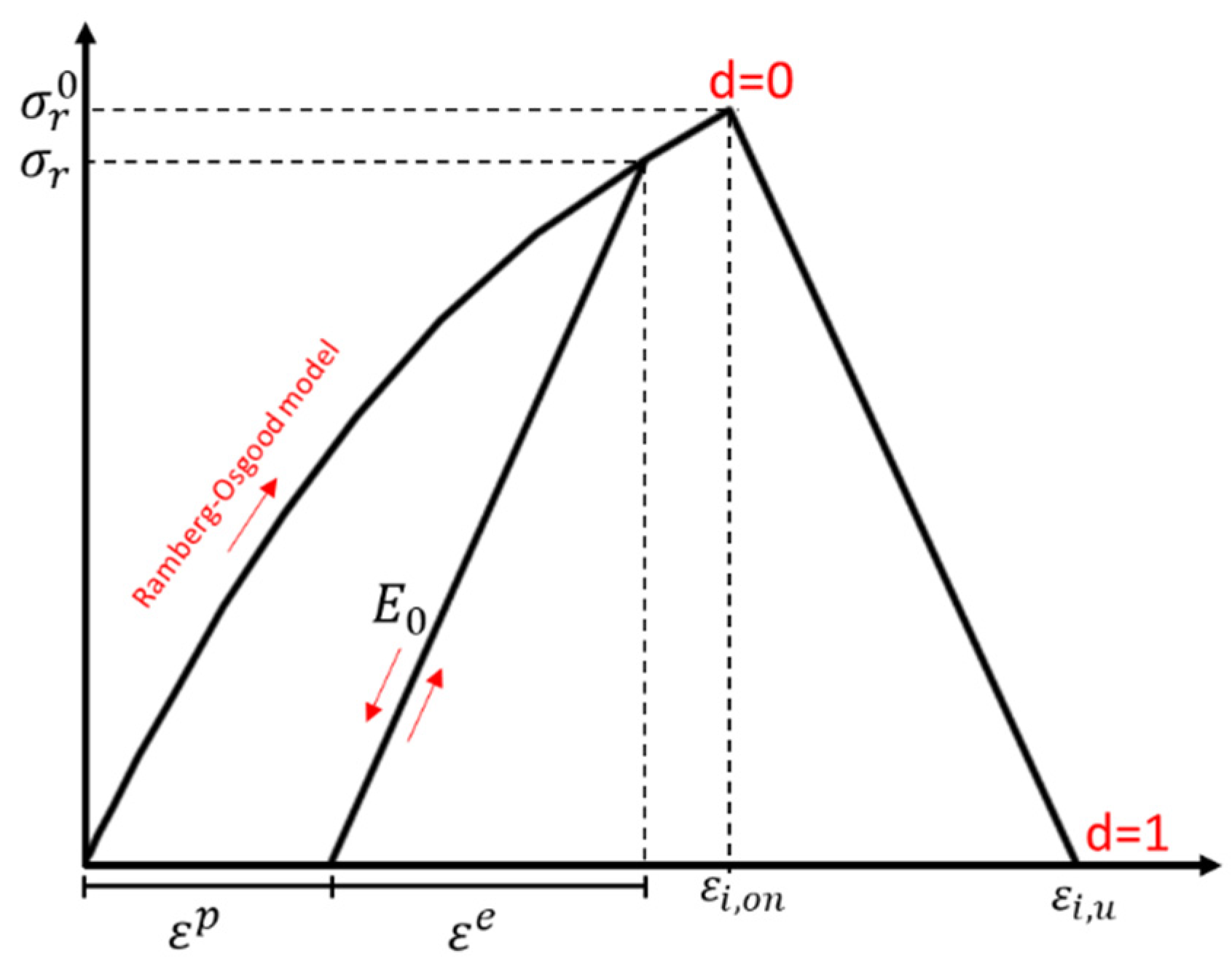


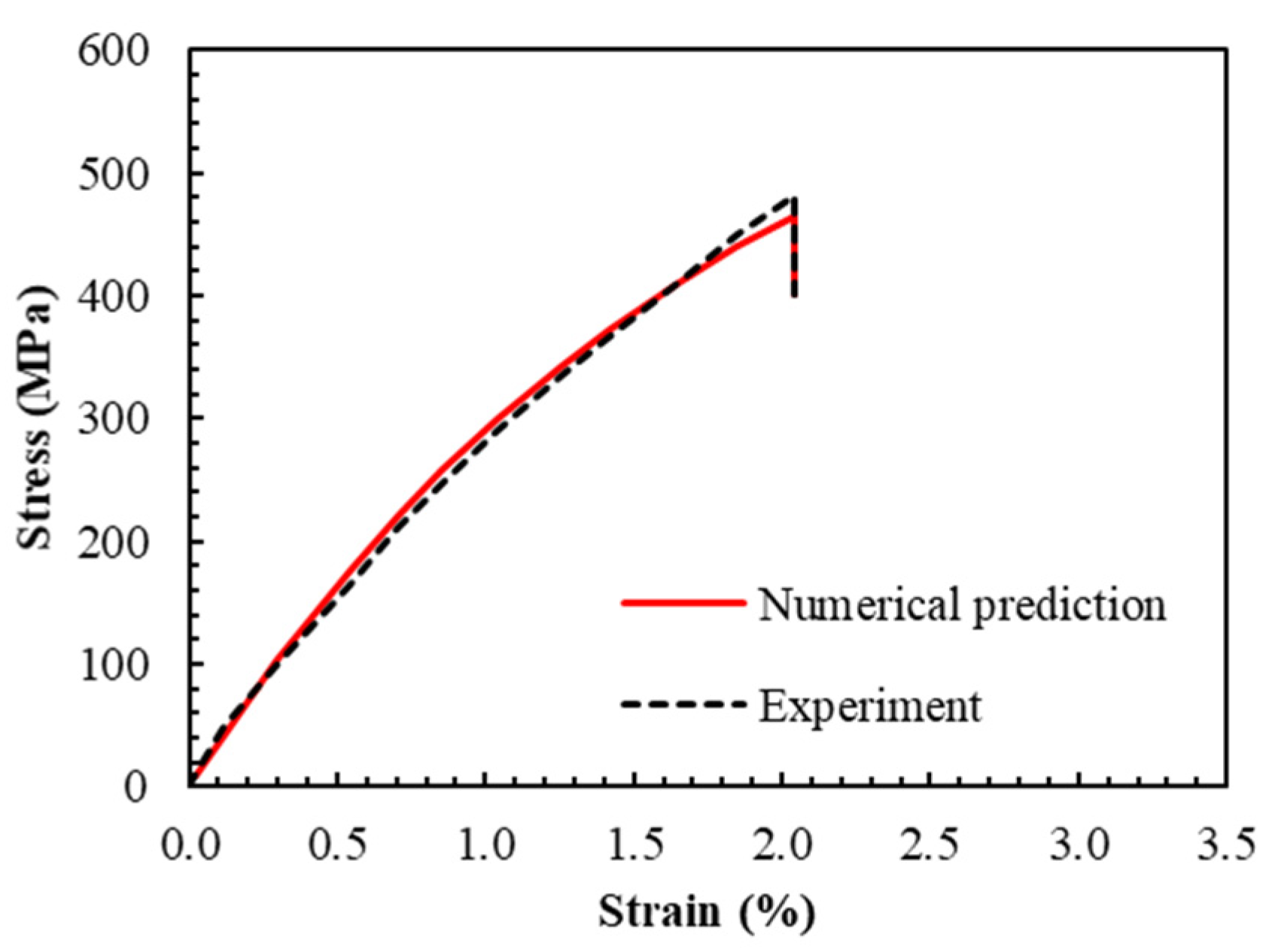
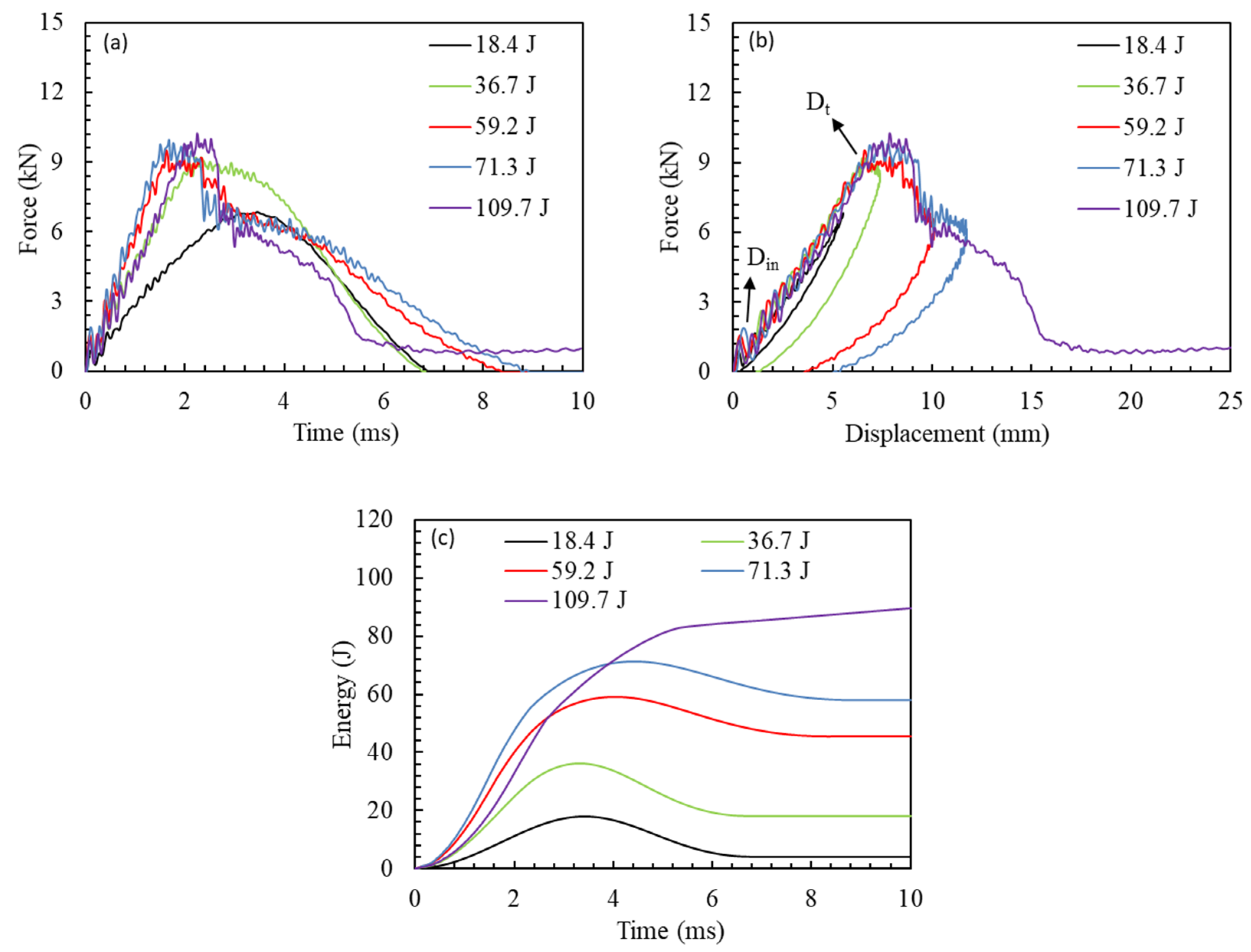


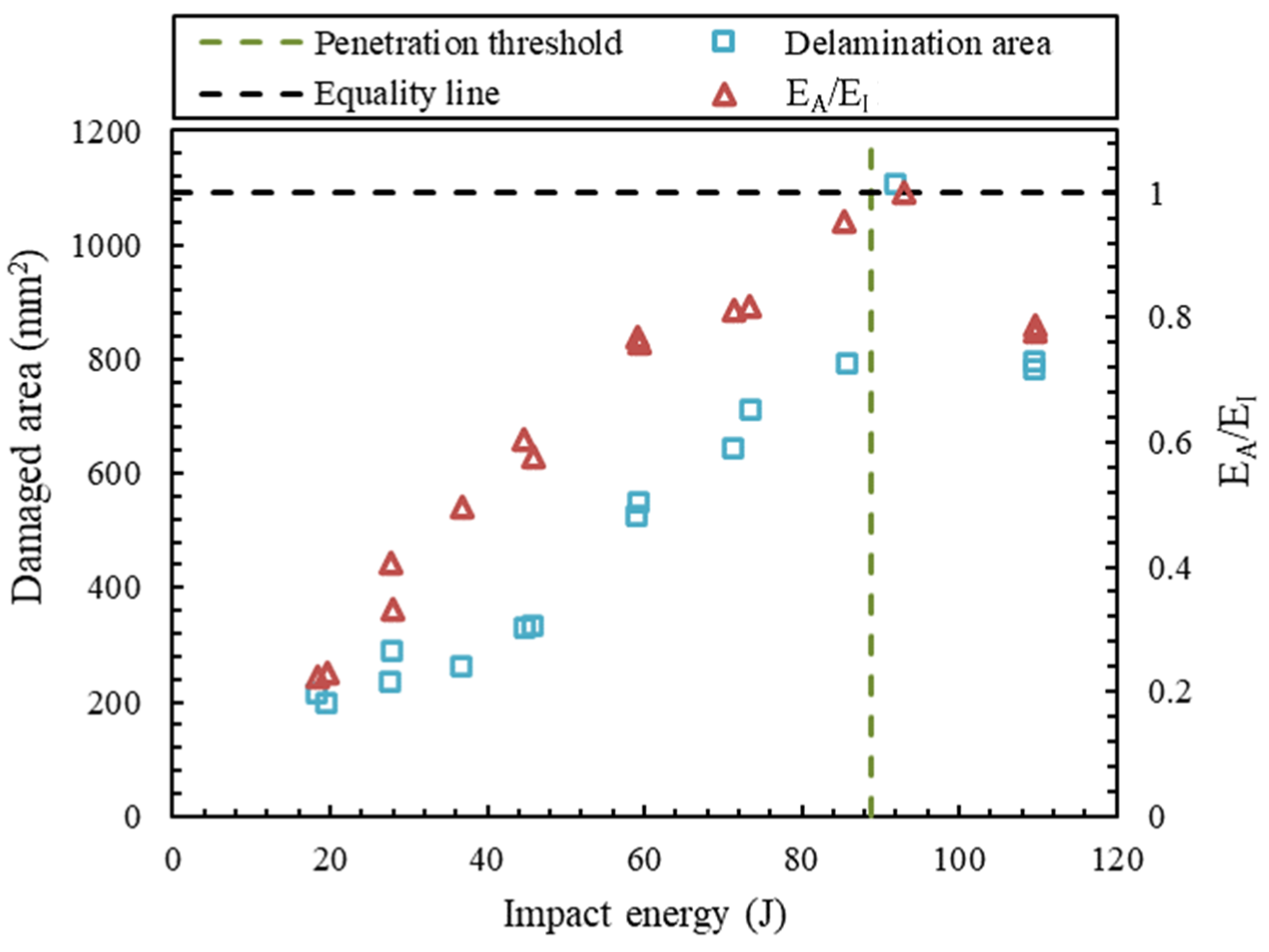




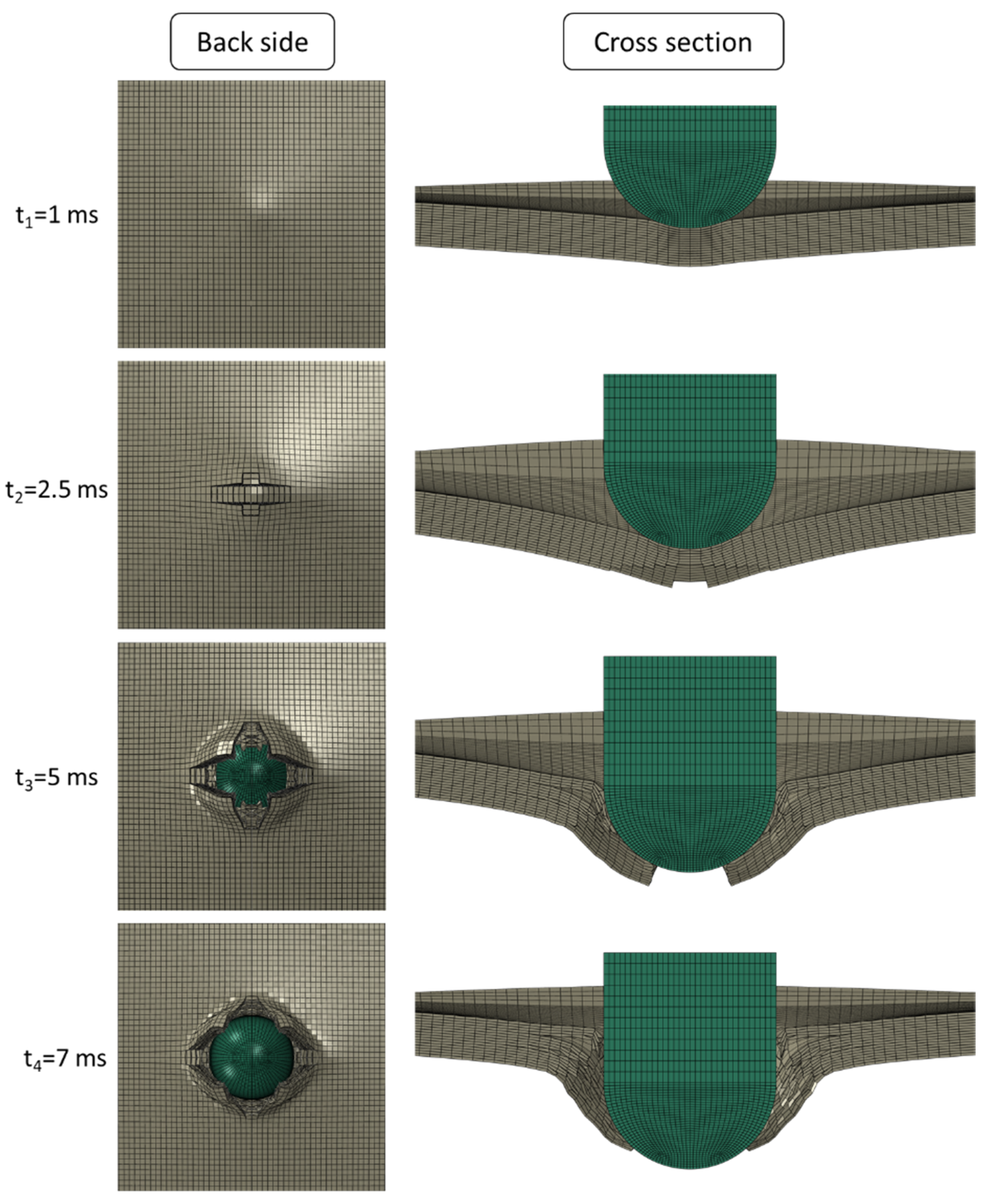

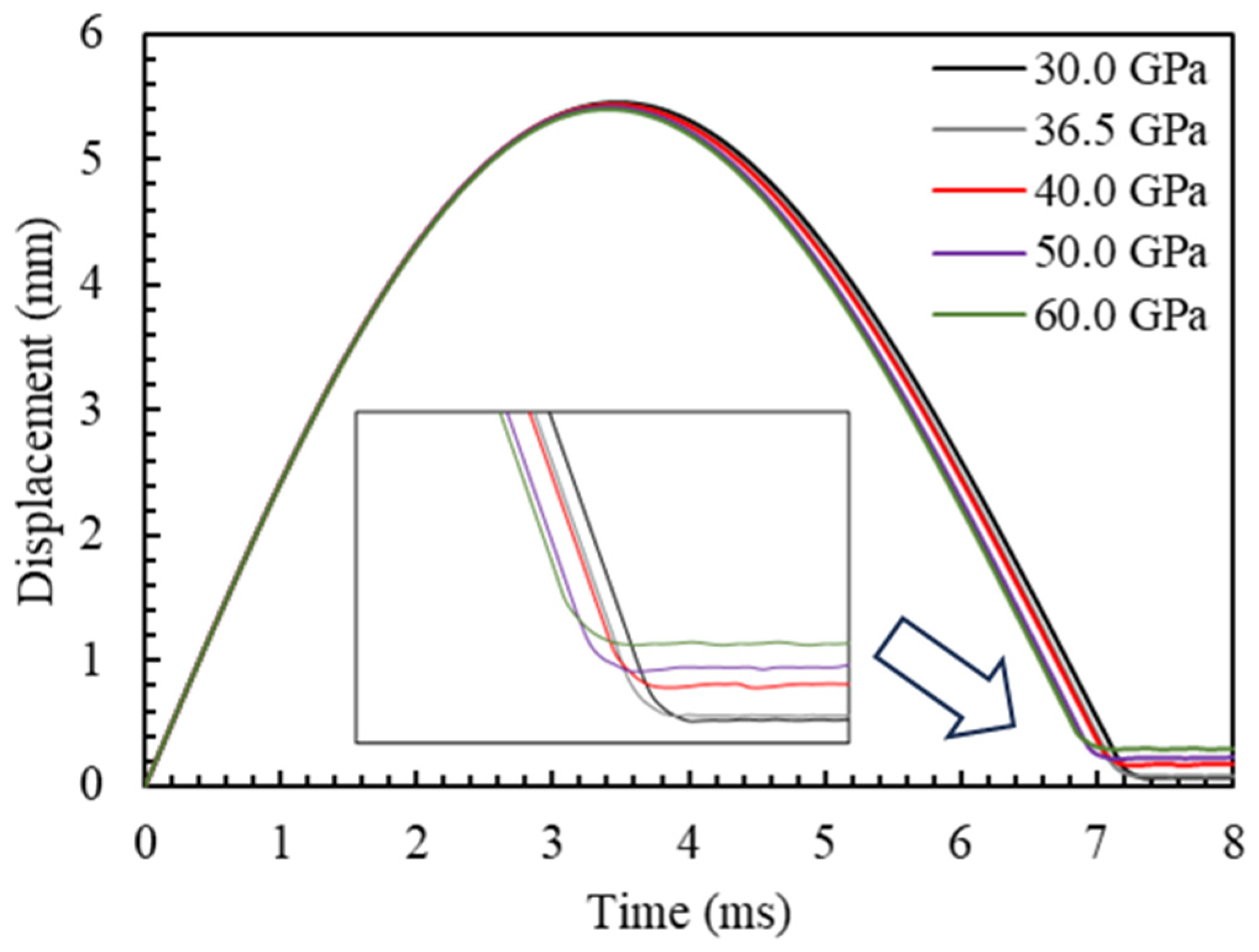


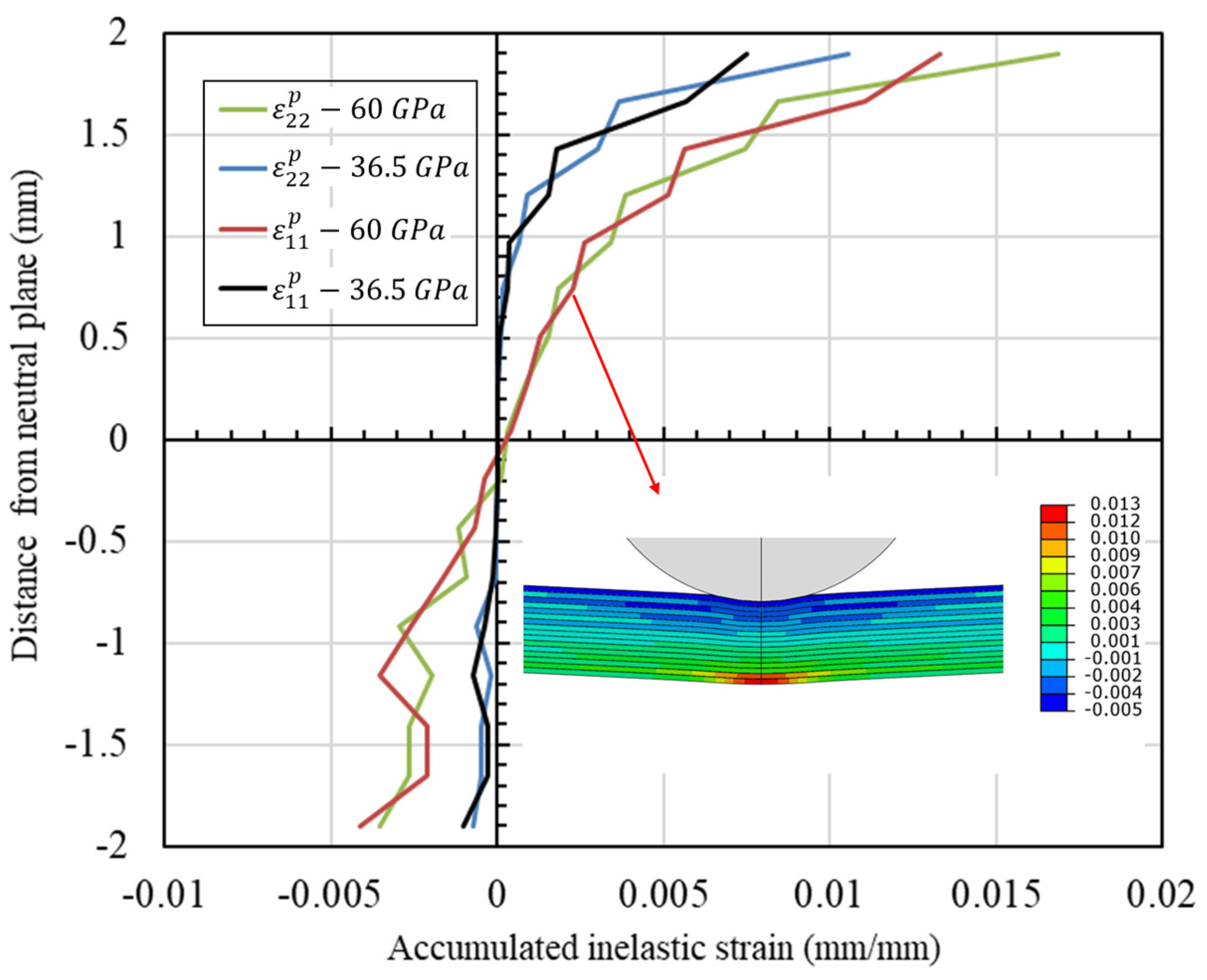
| Damage Indicator | Equivalent Strain | Ultimate Strain |
|---|---|---|
Disclaimer/Publisher’s Note: The statements, opinions and data contained in all publications are solely those of the individual author(s) and contributor(s) and not of MDPI and/or the editor(s). MDPI and/or the editor(s) disclaim responsibility for any injury to people or property resulting from any ideas, methods, instructions or products referred to in the content. |
© 2024 by the authors. Licensee MDPI, Basel, Switzerland. This article is an open access article distributed under the terms and conditions of the Creative Commons Attribution (CC BY) license (https://creativecommons.org/licenses/by/4.0/).
Share and Cite
Rezasefat, M.; Kumar, Y.; da Silva, A.A.X.; Amico, S.C.; Hogan, J.D.; Manes, A. Dynamic Behavior and Permanent Indentation in S2-Glass Woven Fabric Reinforced Polymer Composites under Impact: Experimentation and High-Fidelity Modeling. J. Compos. Sci. 2024, 8, 138. https://doi.org/10.3390/jcs8040138
Rezasefat M, Kumar Y, da Silva AAX, Amico SC, Hogan JD, Manes A. Dynamic Behavior and Permanent Indentation in S2-Glass Woven Fabric Reinforced Polymer Composites under Impact: Experimentation and High-Fidelity Modeling. Journal of Composites Science. 2024; 8(4):138. https://doi.org/10.3390/jcs8040138
Chicago/Turabian StyleRezasefat, Mohammad, Yogesh Kumar, Amanda Albertin Xavier da Silva, Sandro Campos Amico, James David Hogan, and Andrea Manes. 2024. "Dynamic Behavior and Permanent Indentation in S2-Glass Woven Fabric Reinforced Polymer Composites under Impact: Experimentation and High-Fidelity Modeling" Journal of Composites Science 8, no. 4: 138. https://doi.org/10.3390/jcs8040138





